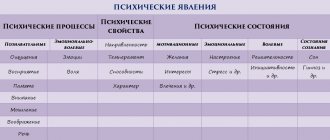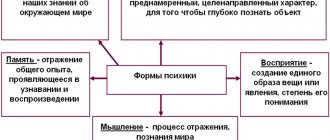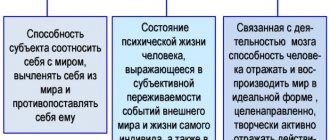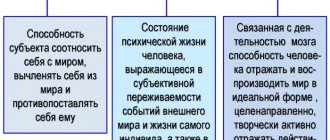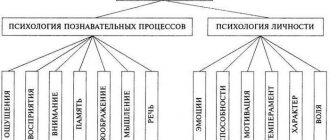A person is able to carry out any activity in various modes. And one of them, as we know, is mental states.
A mental state is a mode of human life that is distinguished by special energy characteristics at the physiological level, and a complex of psychological filters at the psychological level. These filters, in fact, provide a person’s subjective perception of the reality around him.
Together with personality traits and mental processes, mental states represent the main classes of mental phenomena studied by psychology. Mental states influence how mental processes proceed, and, repeating regularly and becoming more stable, they are able to become part of the personality structure, playing the role of its specific properties.
And if this topic seems interesting to you and you want to develop even more in it, we recommend our course “Mental Self-Regulation”, where you will learn real practical techniques for self-motivation, stress management and social adaptation in order to always control your emotional and mental state. Find out more about the course
General ideas about the psyche
The psyche is a multifaceted construct that determines a person’s personality. There are several links in it:
- Mental processes. These are dynamic indicators that are criteria for understanding the world, help to take and analyze information from everything that surrounds a person, form his emotions in a specific episode of life, his behavior, goals and motives, and also regulate communication, depending on the situation, changing gestures and posture, volume and tone of voice, facial expressions. In the process of personality development, they constantly vary.
- Mental properties. Properties include:
- temperament, which is established at birth;
- character, which, when studying personality, also turned out to be largely dependent on the hereditary factor and only 10% on the external one;
- abilities that are both inherent in nature and formed during the development of the individual.
Properties are a static concept, but are subject to relative variation when exposed to a prolonged irritating factor.
- Mental states. Determines exactly which processes and properties of a person will manifest themselves in a given situation and which of them will prevail over others.
Mental properties
Mental properties are the most stable and constantly manifested personality traits, providing a certain level of behavior and activity typical for it. These are mental phenomena that are realized in a certain society.
Mental properties include:
- Temperament;
- Character;
- Capabilities;
- Directionality.
When talking about the mental properties of a personality, we are talking about its essential, more or less stable, permanent features. These are the characteristics that distinguish each person. Their totality determines a person’s individuality, because it is impossible to meet 2 people with exactly the same mental properties.
You should not confuse some isolated cases of manifestation of any traits with mental properties. After all, each of us has happened to forget something, but “forgetfulness” is not a characteristic feature for everyone. Everyone has been in an irritable state at some point, but “irritability” is characteristic only of some. Thus, a mental property can only be a stable and permanent feature of a person, which is developed and formed during life.
Psychological states as the main criteria for personality research
A person's personality in a particular situation is reflected by the psychological state that shapes its response to a stimulus. That is, some emotions prevail over others, gestures change, behavior changes, sometimes even motivation and other processes. The state is a relatively static indicator, however, with long-term identical stimuli, the time-varying state turns into a practically non-variable property.
In the process of personality research, the following components of the mental state were identified:
- Physiology (physical indicators, for example, pulse);
- Motor functions (facial expressions, speech, etc.);
- Emotions (depending on the situation, both positive and negative);
- Cognitive processes (the ability to adequately think, think through your further actions, analyze the situation);
- Behavior (any actions caused by a specific situation);
- Communication skills (the ability to contact and adequately communicate with a person).
All psychological states are divided into two groups: situational and stable (personal). Each group has its own classification.
Situational states are characterized by instability and the individual’s response to a certain atypical situation. They can be:
- general-functional;
- mental stress;
- conflicting.
Stable, that is, those that persist for a long time, are divided into:
- optimal or crisis;
- various borderline states (dementia, psychopathy);
- disturbances of consciousness.
It is necessary to dwell separately on crisis conditions, which can manifest themselves in the form of:
- negativism (the predominance of negative emotions even under optimal conditions);
- opposition (aggression in certain similar situations or towards certain individuals, but similar by some criterion);
- autism (complete social withdrawal).
Yu. V. Shcherbatykh is the founder of another classification of mental states. The classification is presented in the form of a table and thanks to it you can calculate the formula for a certain state, for example, fear or admiration. The table examines 7 criteria, each of which is divided into transitional and extreme variants of the mental state.
My recommendations
Clients often come to me with complaints of chronic fatigue, loss of appetite, and lack of desire to do anything. They do not understand what is happening to them, they report that they have been to many doctors, have undergone a bunch of tests, but the cause of the decrease in performance and apathy has not been established. "What happened with me?" - they ask me. My answer that these symptoms relate to anomalies in the mental state of the individual usually surprises them. However, my initial assumptions are confirmed by the results of psychological tests. At the next stage of working with the client, I tell him about what types of mental states are distinguished in modern psychology, since often, having familiarized themselves with the diagnostic results, they say: “Indicate what refers to the mental states of the individual.”
In most cases, 5-10 sessions with a psychologist are enough to correct the psychological state that occurs when you are in a low mood. I give recommendations on developing reflection skills and teach relaxation techniques. The main method in my work is art therapy. In my opinion, this method is the key to the inner world of the individual. Through art therapeutic exercises, a person finds harmony with himself and learns to manage his emotional field.
Criteria for a mature personality
Before conducting personality research, you should decide on the criteria that a formed, holistic personality must meet. There is no general approach to this concept, but it is customary to consider the most reliable criteria of V.V. Petukhov, who claims that a person:
- must be capable of creativity;
- can be multiple with simultaneous integrity;
- is constantly evolving.
L. I. Bozhovich approached the question more simply, highlighting only two criteria for an individual: the ability to set priorities, sacrificing one’s “want” for the sake of “need,” as well as the ability to manage one’s actions, setting goals and overcoming obstacles.
Negative and positive states
Negative states include: • suffering; • anger; • disgust; • contempt; • shame.
These are asthenic emotions that negatively affect the body, worsen well-being and reduce the supply of vital energy. There is a feeling of chills, shortness of breath, blood circulation slows down, and muscle tone decreases.
Positive emotional states are positive emotions perceived by the subject as good health and mood: joy, interest, satisfaction. They are accompanied by a beneficial expansion of small blood vessels, blood flow to organs, and an increase in motor activity.
Psychological studies of personality
All research methods are divided into 4 categories, united by some common approach to the study of personality.
- Observation. The main ways to assess a personality are through examination, questioning both the person himself and those around him, reading the medical history, if any, reading diaries or autobiographies. The last two sources, as practice shows, are very valuable information.
- Experiment. Includes various studies using equipment. It is also possible to simulate some emergency situations or situations that are important for a particular person to assess his mental state.
- Questionnaires and other similar techniques. They allow you to evaluate many criteria: motivation, focus, self-esteem, willpower, etc.
- Design. Using the techniques of this area, the personality as a whole is determined, without highlighting its individual criteria.
However, in practice all 4 methods are actively used, which can also be mixed, complementing each other, so their separation is conditional.
Diagnostics
Some people have the unique ability to accurately assess their mental state. Physical well-being is the main “barometer” for them. Other people need the help of a psychologist in this matter.
In psychology, determining a person’s mental state is an analysis of his psychophysiological and psychological levels. The study of the psychophysiological level allows us to study the nature of the emerging feeling and determine (if necessary) ways to correct it.
The most popular diagnostic tools are psychological tests. With their help, the mood, well-being and level of activity of an individual are diagnosed. The most indicative results are obtained by such methods as the Luscher color test, SAN, PAT, “Nervous-Mental Tension Questionnaire,” “Relief of Emotions,” and personal anxiety tests.
In medicine, methods for diagnosing mental conditions include ECG and GSR results, heart rate, and brain encephalogram.
This is interesting
The experimental method is subject to widespread criticism for reasons of humanity, but its results always turn out to be the most reliable and interesting for science. For example, Stanley Schachter conducted a very interesting experiment, during which it was found that in an emergency, life-threatening situation, a person prefers to be not alone, despite the understanding of joint death. Further research showed that a person prefers to be close to someone who experiences the same fears or emotions as him. That is, in a threatening situation, a person needs not just a friend, but a “suffering” friend.
Based on the conducted personality studies, it is possible to reliably determine all the criteria and indicators of a person’s psyche in order to create a holistic personal portrait.
Chapter Four. About mental states
Joy is that pleasure or pleasant sensation that is born in us, either at the thought that we possess some desired good, or when satisfying some aspiration, and sometimes a natural need, or a requirement of habit. A feeling of joy sometimes precedes the actual possession of a desired good, or the satisfaction of a habit, and is born from the mere hope that we can obtain the good we strive for. So, for example, a sick person rejoices from the mere hope that he will soon recover; He who has made every effort to acquire any good rejoices at the thought that he will soon achieve his goal. By a strange whim of the human heart, many experience much more joy before receiving any good, from the mere thought of being close to the goal, than after receiving it; so that often the very goal of their thoughts is already disappointed, or at least they feel less pleasure. This probably comes from the imagination, which promises us in advance more pleasures than can be obtained in reality, and gives rise to exaggerated hopes that are not always justified in practice.
The highest degree of joy is called delight. Delight is a tense state in which a person cannot remain for a long time, and which often causes the other extreme, i.e. sad location. Not every person is equally prone to joy or delight: there are people who are not at all capable of an enthusiastic state; others, on the contrary, are delighted with everything.
The feeling of joy should not be confused with gaiety. Cheerfulness refers more to disposition and means some constant tendency to discover a pleasant state of mind, which occurs, if it is unfeigned, but true, from inner contentment, from peace of mind.
The opposite feeling of joy is called sadness. Sadness occurs in the soul at the thought of the good that we either lost or could not obtain, despite all our efforts. Sadness is the stronger the more our imagination reminds us of the lost good, or paints us a picture of the pleasures that this or that good could give us. This is, for example, the state of a mother mourning the death of her son. Her imagination constantly draws her the features of the deceased; she remembers his habits, his intelligence, everything that was so dear to her, in which she found so much pleasure, and all this serves as food for her sadness. Therefore, whoever wants to console a sad person must entertain him, that is, make him not think about his grief, remove from him everything that would remind him of the subject of sadness. Hence it also happens that time heals heart wounds better than verbal consolations.
But we often experience sadness when we see someone else’s grief. Even the mere memory of a neighbor’s grief gives rise to sadness in us; but the very sight of grief, the spectacle of the suffering of a neighbor, especially a person close to us, arouses strong grief in us. In this case, our sadness is sympathy for the suffering of our neighbor. Anyone who carefully observed the state of his soul when it experiences compassion could notice that a person in this state seems to put himself in the place of the sufferer; imagines how he would suffer if he were in a similar position: with a word he arouses in himself the very feeling that is in the sufferer. This is why some weak-hearted people cannot bear the sight of others' suffering; It is as if they themselves are experiencing at this time the torment that appears to their eyes.
It is remarkable that in the human language there are many words to express different types of sadness; while its opposite feeling has only one name - joy. This happens either because in people’s lives there are much more sorrows than joys, or because we feel everything unpleasant more deeply and remember longer, but we soon forget everything joyful.
The weakest degree of sadness is indicated by the word grief, sadness. The word annoyance sometimes expresses a weak kind of sadness, and sometimes sadness combined with another unpleasant feeling - anger. Sorrow sometimes expresses the highest degree of sadness, and sometimes it is used in a sense completely equivalent to the word sadness. The highest degree of sadness is also called despondency. It is associated with a loss of energy, a decline in all physical and spiritual strength. However, generally speaking, it is difficult to give an exact and definite meaning to these words: for a feeling is always difficult to express in words. When, for example, I say “annoyance,” then everyone, from their own experience, can better understand what I want to express with this word than when I try to explain this feeling in other words.

